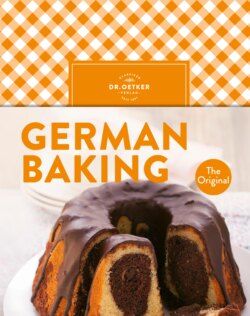Читать книгу German Baking - Dr. Oetker - Страница 4
На сайте Литреса книга снята с продажи.
THERE’S SO MUCH TO SAVOUR IN GERMAN BAKING!
ОглавлениеThe day starts with sweet or savoury rolls, later on some tasty sandwiches can be enjoyed during a break and it is not only on Sundays that a piece of cake or biscuits are served with afternoon coffee. Every region has, of course, its own specialities – but Kugelhopf, marble, Danube Waves and apple cake go down well everywhere. The many bread specialities are also unique – where else can rye bread with pumpkin seeds be found? And a German Christmas without the famous stollen is unimaginable.
Austria’s coffeehouse culture has left its mark on the entire German-speaking world. In spite of the ‘Coffee-to-go’ boom, traditional cafés are still everywhere: with plenty of time to spare and friends to meet, a piece of Frankfurt crown, some cream puffs or Black Forest Gateau with a pot of coffee goes down a treat.
A ‘bee sting’ may hurt and sound dangerous but this particular one is pure pleasure. It is the name given to the highly popular yeast dough flat cake, which is covered with almonds, sometimes has a custard filling and gets its irresistibly sweet taste from caramelised sugar.
‘Ich bin ein Berliner!’ American president John F. Kennedy intended this sentence to be a synonym for free people. A ‘Berliner’ is, however, also edible: more than 200 years ago, the Prussian army invented a fried yeast-based cake, a doughnut, which is traditionally made on New Year’s Eve as well as during the carnival season in many regions of Germany. The only place that people do not eat ‘Berliner’ is in Berlin – there, the cake which is filled with jam and sprinkled with icing (confectioner’s) sugar, is known as a ‘Pfannkuchen’, or ‘pancake’.
Even vegetarians like these ‘animals’! For generations, the legendary ‘Cold Dog’ has been one of the Germans’ favourite cakes – and it does not even have to go in the oven. In a rectangular cake tin, layers of petit beurre biscuits and chocolate cream are alternately placed on top of each other. After five hours in the fridge, the cake is turned out of the tin and cut – and childhood memories come flooding back. The ‘mole cake’ is a relatively recent recipe but has also now become a children’s birthday classic and adults find the combination of banana, cherries, cream, nuts and chocolate equally irresistible.
When it comes to crumble cake, there are no small portions! Immediately visions of a deliciously smelling cake on large baking sheets comes to mind, with the crumble topping of flakes made from sugar, fat and flour on top. Flat cakes, with their many regional variations, have been highly popular in Germany since the nineteenth century. They are cut into small pieces after baking and taste great either with or without cream – you simply have to take another piece.
A beer garden without pretzels is unthinkable! Every year, millions of visitors come to the Oktoberfest in Munich. Bavarian women in dirndls and the men in lederhosen are world famous – and a litre of beer and a Weißwurst, or veal sausage, are always eaten with a pretzel! They originally come from Southern Germany and are available in German beer gardens and brewery taverns all year round – and fortunately, they even taste good in the north!
